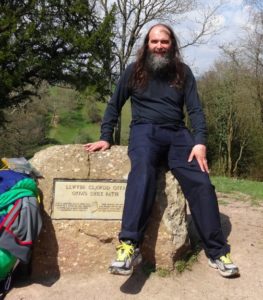I walked Offa's Dyke in 2013 as part of a longer journey around the whole periphery of Wales linking Offa's Dyke with the Wales Coast Path. The Offa's Dyke portion of the walk took twelve walking days between 20th April and 11th of May, with a gap at Kington to go to a conference in Paris (I granted it honorary Welsh status) and a couple of days at Wrexham to give a talk there.I was a real walking newbie when I started from Sedbury Cliffs. It was only the third day of my overall round Wales walk having started at Cardiff on April 18th, and prior to that I had not walked any distance since I was a teenager, thirty-five years earlier. Living on Tiree, one of the Scottish islands, where the highest point is not much more than a hundred metres, I even found the (very slight) climb from Severn Bridge into Chepstow a challenge, and wondered then if I would ever make the distance.However, the body is amazingly resilient and, by the time I got to the Clwydian Hills in the north, I had become one of these really-annoying-people, who climb mountains as if they were no effort. I recall powering past Duke of Edinburgh Award teenagers on the misty slopes of Moel Famau and realising my new-found really-annoying status. Those who are already fed up with my too easily gained fitness will be pleased to know that I got my come-uppance along the north coast of Wales, when my body gave out on me €¦ but that is another story.The combination of Offa's Dyke signage and Harvey's Maps really spoilt me, but it was only weeks later, frequently lost in north-west Wales where the (relatively) poorly way-marked Wales 'Coast' Path frequently struck far inland, that I truly appreciated the forty-five years of maturity of Offa's Dyke Path. The only times I was significantly confused on Offa's Dyke were near Knighton amongst the proliferation of individually well-marked paths and trails (several including the word 'Offa'), and just north of Llandegla where a farmer had systematically stripped all footpath roundels from his land.One of the other joys of Offa's Dyke was the number of churches that offered tea making facilities, including the mediaeval church with a fully equipped mini-kitchen beneath the bell tower. In the New Testament the letter to the Hebrews says, "Do not neglect to show hospitality to strangers, for by this some have entertained angels unaware." (Heb. 13:2). I'm no angel, but I am always glad of a cuppa.Although there were a few hard days, not least the first and last, there were far more high points. People were important, not least the Welsh-speaking Lancastrian with whom I walked from Monmouth to Pandy, and the Three Dykers, whom I shared an evening with at Pandy and met intermittently as we passed and re-passed one another over several days.Offa's Dyke SouthStarting in the south, nights at the Severn Bridge services (strictly 'off path') and at Llandogo reconnected with childhood memories of both, and I loved the long ridgeway across the Black Mountains between Pandy and Hay-on-Wye, where, thankfully for the health of my wallet, I arrived after the bookshops had closed and left before they had opened. Also fortunate that day was the weather: glorious sunshine where just a few weeks earlier the ridge top would have been head-high in snowdrifts and impassable, but when I passed only small patches of snow remained in shadowed hollows on the north-facing slopes of the Black Mountain.Offa's Dyke Mid WalesIn the mid-sections, I recall the contrast of Kington, a memorial to the 1950s, and Knighton where I saw a space car. For those who love the aesthetics of decay, spend time with the rusting, disused petrol pumps on the Blue Bell crossroads, just south of Montgomery. Did the inn at this old crossing of ways once host a blacksmith's forge, a liminal place between places, all fire and iron? Then, just a few miles further north, in the hills between Forden and Welshpool, the (misbegotten?) birthplace of Leylandii, the ubiquitous scourge of suburbia.The wide Severn plain was one of those days of walking where there seems little change from step to step, as if the world rolled beneath my feet, but never progressed. Beyond this, Llanymynech signals the return to the hills, nestled beneath a castle-like quarry that served the lime kilns now protected in Llanymynech Heritage Area; a village where houses float in no-mans land between Wales and England, and the hotel, sadly closed, where the bar straddled two countries and drinkers sidled from end to end depending on the time of day and differing drinking hours of the two nations.Offa's Dyke NorthThe Pontcysyllte Aqueduct strung precipitously across the Dee Valley takes you to the final section. The footpath happily has a low wall where the brave can glance down to the river 120 feet below; this unlike the canal itself that on its other side has no barrier between the water's edge and the view (and drop) to the valley upstream. The sugar-loaf of Dinas Bran rises high over Llangollen where, if you wish, you can stay in a hotel next to a taxidermist before the last few days across the Clwydian range. I did this last stage in two days: breaking at Ruthin (some miles off the path), but I would advise three. The sea looks tantalisingly close as you look down from the mountains above Bodfari, but you have many miles still to go before the cut metal monument of the northern end of the Offa's Dyke Path on Prestatyn seafront.For more about the whole round-Wales adventure see http://alanwalks.wales
